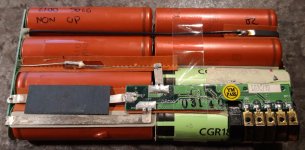Chr$
Experienced Member
This is really a general battery query, but is from a 1997 Gateway 2000 laptop with a P133 CPU so sort of fits here too.
This is the internals of the battery pack. It's made up of 4 pairs of cells. I had to replace 2 horrible leaky cells, as you can see. I then manually charged each of the cell pairs up to 4.08ish volts each, ensuring that they all matched as well as possible and that the voltage of each of the 4 pairs was stable over time (it was, they were all rock solid at 4.08 - 4.11v). When I first plugged it into the laptop it showed 0% charge, which is odd, as they were all charged and measuring a little over 16v in total. Over time it showed 1%, 2% etc, up to about 8% and then all of a sudden 100%. So I tried to run the laptop on the battery and it got down to about 93% (indicated) and then shut down - it was only good for 2 - 3 minutes in total. I removed it, measured and it was still showing just over 16v at the main output connectors.
I let it charge in the laptop overnight and it's pretty much the same story. It has 16v+ according to my multi meter but shows as completely empty and doesn't have enough power to run the laptop for more than 20 seconds or so.
Is there anything I can do about it? Does the BMS need a reset somehow? Should I run all the cell pairs down to empty (3v or so) and then try to charge it in the laptop again. Should I simply replace all the cells for new ones.
Happy to hear suggestions and happy new year.
This is the internals of the battery pack. It's made up of 4 pairs of cells. I had to replace 2 horrible leaky cells, as you can see. I then manually charged each of the cell pairs up to 4.08ish volts each, ensuring that they all matched as well as possible and that the voltage of each of the 4 pairs was stable over time (it was, they were all rock solid at 4.08 - 4.11v). When I first plugged it into the laptop it showed 0% charge, which is odd, as they were all charged and measuring a little over 16v in total. Over time it showed 1%, 2% etc, up to about 8% and then all of a sudden 100%. So I tried to run the laptop on the battery and it got down to about 93% (indicated) and then shut down - it was only good for 2 - 3 minutes in total. I removed it, measured and it was still showing just over 16v at the main output connectors.
I let it charge in the laptop overnight and it's pretty much the same story. It has 16v+ according to my multi meter but shows as completely empty and doesn't have enough power to run the laptop for more than 20 seconds or so.
Is there anything I can do about it? Does the BMS need a reset somehow? Should I run all the cell pairs down to empty (3v or so) and then try to charge it in the laptop again. Should I simply replace all the cells for new ones.
Happy to hear suggestions and happy new year.

